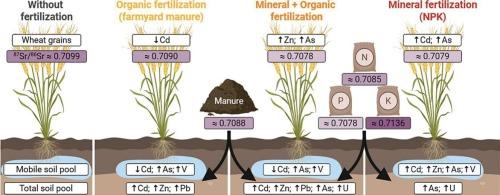长期施肥试验中施肥对土壤中金属(样物质)向小麦转移的影响——以87Sr/86Sr同位素为示踪剂
IF 9.7
1区 环境科学与生态学
Q1 ENVIRONMENTAL SCIENCES
引用次数: 0
摘要
化肥被广泛用于维持粮食生产,但它会改变土壤化学,并可能向农业系统提供有毒金属。本研究首次研究了农业土壤(包括总库和流动库)和小麦籽粒中选择性金属(样态)s (Zn、Sr、V、As、Cd、Pb和U)与87Sr/86Sr同位素比值的发生情况。在德国巴德Lauchstädt进行为期120年的静态施肥试验,从4种施肥处理(氮磷钾、有机肥、无机组合 + 有机和未施肥对照)中选取一种进行样品采集。施肥处理改变了土壤pH值和有机碳,导致矿物肥降低了pH值,增加了阳离子(Cd、Zn、Sr)的流动性,而有机肥增加了pH值,增强了非阳离子元素(V、As)的流动性。这些影响导致矿质施肥小麦籽粒中镉含量较高,矿质 + 有机小麦籽粒中砷含量较高。施肥使土壤和小麦籽粒87Sr/86Sr比值向施用肥料偏移,矿质和矿质 + 有机小麦籽粒继承了三超磷特征(0.70778),有机小麦籽粒与粪肥匹配(0.70883)。流动土壤池87Sr/86Sr比值与流动As、V、P相关,表明87Sr/86Sr比值既反映了肥料来源,也反映了共生金属(样态)的流动性。总体而言,本研究证明了施肥对土壤和小麦中金属(样蛋白)的富集,并建立了87Sr/86Sr比值作为肥料影响的可靠示踪剂。这些发现强调需要有针对性的施肥策略来减少农业生态系统中的污染物积累。本文章由计算机程序翻译,如有差异,请以英文原文为准。

Impacts of fertilization on metal(loid) transfer from soil to wheat in a long-term fertilization experiment – using 87Sr/86Sr isotopes as metal(loid) tracer
Fertilizers are widely used to sustain food production but can alter soil chemistry and potentially contribute toxic metal(loid)s to agricultural systems. For the first time, this study examined the occurrence of select metal(loid)s (Zn, Sr, V, As, Cd, Pb, and U) alongside the 87Sr/86Sr isotope ratio in agricultural soil— both total and mobile pools— and wheat grain. Samples were collected from one of four fertilization treatments— mineral (NPK), organic (manure), combined mineral + organic, and unfertilized controls— within the 120-year Static Fertilization Experiment in Bad Lauchstädt, Germany. Fertilization treatments altered soil pH and organic carbon resulting in mineral fertilization lowering pH and increasing cation mobility (Cd, Zn, Sr), whereas organic fertilization increased pH and enhanced the mobility of non-cationic elements (V, As). These effects translated into higher Cd in mineral-fertilized wheat grain and higher As in mineral + organic wheat grain. Fertilization shifted the 87Sr/86Sr ratios in soils and wheat grains toward that of the applied fertilizers, with mineral and mineral + organic wheat grains inheriting the triple super phosphate signature (0.70778) and organic wheat grains matching manure (0.70883). The 87Sr/86Sr ratio in the mobile soil pool was correlated with mobile As, V, and P, demonstrating that the 87Sr/86Sr ratio reflects both fertilizer source and the mobility of select co-occurring metal(loid)s. Overall, this study demonstrates metal(loid) enrichment in soil and wheat from fertilization and establishes 87Sr/86Sr ratio as a robust tracer of fertilizer impacts. These findings underscore the need for targeted fertilization strategies to reduce contaminant accumulation in agroecosystems.
求助全文
通过发布文献求助,成功后即可免费获取论文全文。
去求助
来源期刊

Environment International
环境科学-环境科学
CiteScore
21.90
自引率
3.40%
发文量
734
审稿时长
2.8 months
期刊介绍:
Environmental Health publishes manuscripts focusing on critical aspects of environmental and occupational medicine, including studies in toxicology and epidemiology, to illuminate the human health implications of exposure to environmental hazards. The journal adopts an open-access model and practices open peer review.
It caters to scientists and practitioners across all environmental science domains, directly or indirectly impacting human health and well-being. With a commitment to enhancing the prevention of environmentally-related health risks, Environmental Health serves as a public health journal for the community and scientists engaged in matters of public health significance concerning the environment.
 求助内容:
求助内容: 应助结果提醒方式:
应助结果提醒方式:


